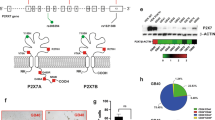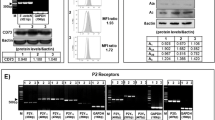Abstract
Gliomas are the most lethal tumors of central nervous system. ATP is an important signaling molecule in CNS and it is a selective P2X7 purinergic receptor ligand at high concentrations. Herein, we investigated whether the activation of P2X7R might be implicated in death of a radiosensitive human glioma lineage. The effects of P2X7R agonists (ATP and BzATP) and irradiation (2 Gy) on glioma cells were analyzed by MTT assay and annexin-V/PI determination, whereas mRNA and protein P2X7R expression was assessed by qRT-PCR and flow cytometry, respectively. P2X7R pore formation was functionality examined by analyzing ethidium bromide uptake. The human glioma cells U-138 MG and U-251 MG were resistant to death when treated with either ATP (5 mM) or BzATP (100 μM), but the radiosensitive M059J glioma cells displayed a significant decrease of cell viability (32.4 ± 4.1 % and 25.6 ± 3.3 %, respectively). The M059J lineage expresses significantly higher mRNA P2X7R levels when compared to the U-138 MG and U-251 cell lines (0.40 ± 0.00; 0.28 ± 0.01, and 0.31 ± 0.01, respectively), and irradiation upregulated P2X7R expression (0.55 ± 0.08) in this lineage. Noteworthy, P2X7R protein doubled after irradiation on M059J lineage, and increased in 50 % and 42.6 % when comparing M059J-irradiated to irradiated U-138 MG and U-251 MG cells, respectively. Ethidium bromide uptake was significantly increased in 104 % and 77.8 % when comparing M059J to U-138 MG and U-251MG, respectively. Finally, the selective P2X7R antagonist A740003 significantly decreased the cell death caused by irradiation. We provide novel evidence indicating that M059J human glioma cell line is ATP-P2X7R sensitive, pointing out the relevance of the purinergic P2X7R on glioma radiosensitivity.






Similar content being viewed by others
References
Meijer DH, Maguire CA, LeRoy SG, Sena-Esteves M (2009) Controlling brain tumor growth by intraventricular administration of an AAV vector encoding IFN-beta. Cancer Gene Ther 16(8):664–671. doi:10.1038/cgt.2009.8
Tamajusuku AS, Villodre ES, Paulus R, Coutinho-Silva R, Battasstini AM, Wink MR, Lenz G (2010) Characterization of ATP-induced cell death in the GL261 mouse glioma. J Cell Biochem 109(5):983–991. doi:10.1002/jcb.22478
Daido S, Yamamoto A, Fujiwara K, Sawaya R, Kondo S, Kondo Y (2005) Inhibition of the DNA-dependent protein kinase catalytic subunit radiosensitizes malignant glioma cells by inducing autophagy. Cancer Res 65(10):4368–4375. doi:10.1158/0008-5472.CAN-04-4202
Sun SH (2010) Roles of P2X7 receptor in glial and neuroblastoma cells: the therapeutic potential of P2X7 receptor antagonists. Mol Neurobiol 41(2–3):351–355. doi:10.1007/s12035-010-8120-x
Verkhratsky A, Krishtal OA, Burnstock G (2009) Purinoceptors on neuroglia. Mol Neurobiol 39(3):190–208. doi:10.1007/s12035-009-8063-2
Wei W, Ryu JK, Choi HB, McLarnon JG (2008) Expression and function of the P2X(7) receptor in rat C6 glioma cells. Cancer Lett 260(1–2):79–87. doi:10.1016/j.canlet.2007.10.025
Morrone FB, Horn AP, Stella J, Spiller F, Sarkis JJ, Salbego CG, Lenz G, Battastini AM (2005) Increased resistance of glioma cell lines to extracellular ATP cytotoxicity. J Neurooncol 71(2):135–140. doi:10.1007/s11060-004-1383-1
Ohshima Y, Tsukimoto M, Takenouchi T, Harada H, Suzuki A, Sato M, Kitani H, Kojima S (2010) gamma-Irradiation induces P2X(7) receptor-dependent ATP release from B16 melanoma cells. Biochim Biophys Acta 1800(1):40–46. doi:10.1016/j.bbagen.2009.10.008
Zheng M, Morgan-Lappe SE, Yang J, Bockbrader KM, Pamarthy D, Thomas D, Fesik SW, Sun Y (2008) Growth inhibition and radiosensitization of glioblastoma and lung cancer cells by small interfering RNA silencing of tumor necrosis factor receptor-associated factor 2. Cancer Res 68(18):7570–7578. doi:10.1158/0008-5472.CAN-08-0632
McLaughlin N, Annabi B, Bouzeghrane M, Temme A, Bahary JP, Moumdjian R, Beliveau R (2006) The survivin-mediated radioresistant phenotype of glioblastomas is regulated by RhoA and inhibited by the green tea polyphenol (−)-epigallocatechin-3-gallate. Brain Res 1071(1):1–9. doi:10.1016/j.brainres.2005.10.009
Virsik-Kopp P, Rave-Frank M, Hofman-Huther H, Schmidberger H (2003) Role of DNA-PK in the process of aberration formation as studied in irradiated human glioblastoma cell lines M059K and M059J. Int J Radiat Biol 79(1):61–68
Hoppe BS, Jensen RB, Kirchgessner CU (2000) Complementation of the radiosensitive M059J cell line. Radiat Res 153(2):125–130
Riteau N, Gasse P, Fauconnier L, Gombault A, Couegnat M, Fick L, Kanellopoulos J, Quesniaux VF, Marchand-Adam S, Crestani B, Ryffel B, Couillin I (2010) Extracellular ATP is a danger signal activating P2X7 receptor in lung inflammation and fibrosis. Am J Respir Crit Care Med 182(6):774–783. doi:10.1164/rccm.201003-0359OC
Pelegrin P, Surprenant A (2009) Dynamics of macrophage polarization reveal new mechanism to inhibit IL-1beta release through pyrophosphates. EMBO J 28(14):2114–2127. doi:10.1038/emboj.2009.163
Lemaire I, Falzoni S, Zhang B, Pellegatti P, Di Virgilio F (2011) The P2X7 receptor and Pannexin-1 are both required for the promotion of multinucleated macrophages by the inflammatory cytokine GM-CSF. J Immunol 187(7):3878–3887. doi:10.4049/jimmunol.1002780
Luheshi NM, Giles JA, Lopez-Castejon G, Brough D (2011) Sphingosine regulates the NLRP3-inflammasome and IL-1beta release from macrophages. Eur J Immunol. doi:10.1002/eji.201142079
Thomas LM, Salter RD (2010) Activation of macrophages by P2X7-induced microvesicles from myeloid cells is mediated by phospholipids and is partially dependent on TLR4. J Immunol 185(6):3740–3749. doi:10.4049/jimmunol.1001231
Ulmann L, Hirbec H, Rassendren F (2010) P2X4 receptors mediate PGE2 release by tissue-resident macrophages and initiate inflammatory pain. EMBO J 29(14):2290–2300. doi:10.1038/emboj.2010.126
Rho HW, Lee BC, Choi ES, Choi IJ, Lee YS, Goh SH (2010) Identification of valid reference genes for gene expression studies of human stomach cancer by reverse transcription-qPCR. BMC Cancer 10:240. doi:10.1186/1471-2407-10-240
Ben Yebdri F, Kukulski F, Tremblay A, Sevigny J (2009) Concomitant activation of P2Y(2) and P2Y(6) receptors on monocytes is required for TLR1/2-induced neutrophil migration by regulating IL-8 secretion. Eur J Immunol 39(10):2885–2894. doi:10.1002/eji.200939347
Morrone FB, Jacques-Silva MC, Horn AP, Bernardi A, Schwartsmann G, Rodnight R, Lenz G (2003) Extracellular nucleotides and nucleosides induce proliferation and increase nucleoside transport in human glioma cell lines. J Neurooncol 64(3):211–218
Jacques-Silva MC, Bernardi A, Rodnight R, Lenz G (2004) ERK, PKC and PI3K/Akt pathways mediate extracellular ATP and adenosine-induced proliferation of U138-MG human glioma cell line. Oncology 67(5–6):450–459. doi:10.1159/000082930
Morrone FB, Oliveira DL, Gamermann P, Stella J, Wofchuk S, Wink MR, Meurer L, Edelweiss MI, Lenz G, Battastini AM (2006) In vivo glioblastoma growth is reduced by apyrase activity in a rat glioma model. BMC Cancer 6:226. doi:10.1186/1471-2407-6-226
Kim JE, Ryu HJ, Yeo SI, Kang TC (2010) P2X7 receptor regulates leukocyte infiltrations in rat frontoparietal cortex following status epilepticus. J Neuroinflammation 7:65. doi:10.1186/1742-2094-7-65
Smart ML, Gu B, Panchal RG, Wiley J, Cromer B, Williams DA, Petrou S (2003) P2X7 receptor cell surface expression and cytolytic pore formation are regulated by a distal C-terminal region. J Biol Chem 278(10):8853–8860. doi:10.1074/jbc.M211094200M211094200
Pelegrin P, Surprenant A (2006) Pannexin-1 mediates large pore formation and interleukin-1beta release by the ATP-gated P2X7 receptor. EMBO J 25(21):5071–5082. doi:10.1038/sj.emboj.7601378
White N, Burnstock G (2006) P2 receptors and cancer. Trends Pharmacol Sci 27(4):211–217. doi:10.1016/j.tips.2006.02.004
Wilhelm K, Ganesan J, Muller T, Durr C, Grimm M, Beilhack A, Krempl CD, Sorichter S, Gerlach UV, Juttner E, Zerweck A, Gartner F, Pellegatti P, Di Virgilio F, Ferrari D, Kambham N, Fisch P, Finke J, Idzko M, Zeiser R (2010) Graft-versus-host disease is enhanced by extracellular ATP activating P2X7R. Nat Med 16(12):1434–1438. doi:10.1038/nm.2242
(2008) Comprehensive genomic characterization defines human glioblastoma genes and core pathways. Nature 455(7216):1061–1068. doi:10.1038/nature07385
Acknowledgments
This work was supported by Fundação de Amparo à Pesquisa do Estado do Rio Grande do Sul (FAPERGS) [Proc. 1016960], Coordenação de Aperfeiçoamento de Pessoal de Nível Superior (CAPES) and Financiadora de Estudos e Projetos (FINEP) [(PUCRSINFRA) # 01.11.0014-00]. We thank for Dr. Carlos Henrique Barrios for the gift of the cell line, Dr. Robson Coutinho-Silva for the gift of compounds and Julia Cisilotto for help with the cell counting.
Author information
Authors and Affiliations
Corresponding author
Rights and permissions
About this article
Cite this article
Gehring, M.P., Pereira, T.C.B., Zanin, R.F. et al. P2X7 receptor activation leads to increased cell death in a radiosensitive human glioma cell line. Purinergic Signalling 8, 729–739 (2012). https://doi.org/10.1007/s11302-012-9319-2
Received:
Accepted:
Published:
Issue Date:
DOI: https://doi.org/10.1007/s11302-012-9319-2




